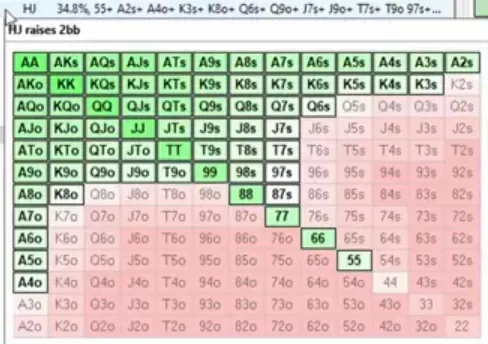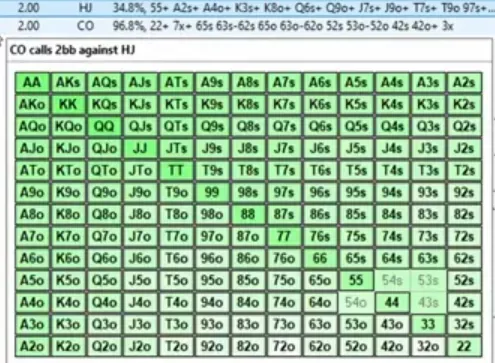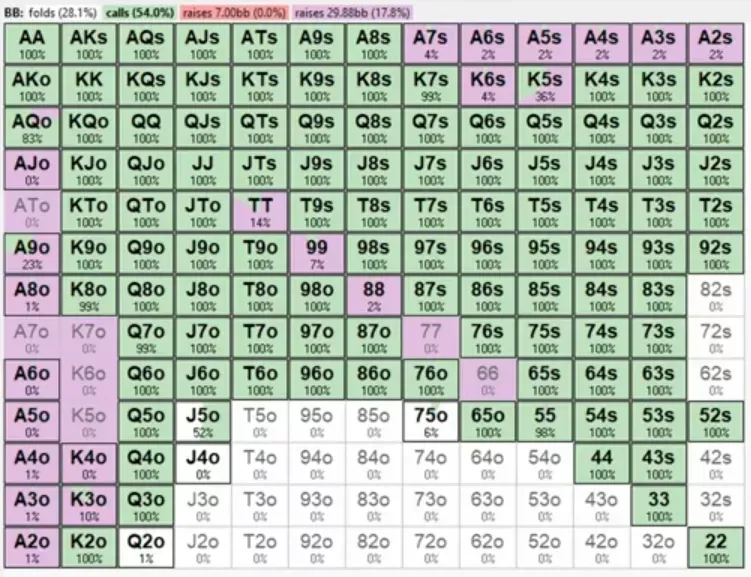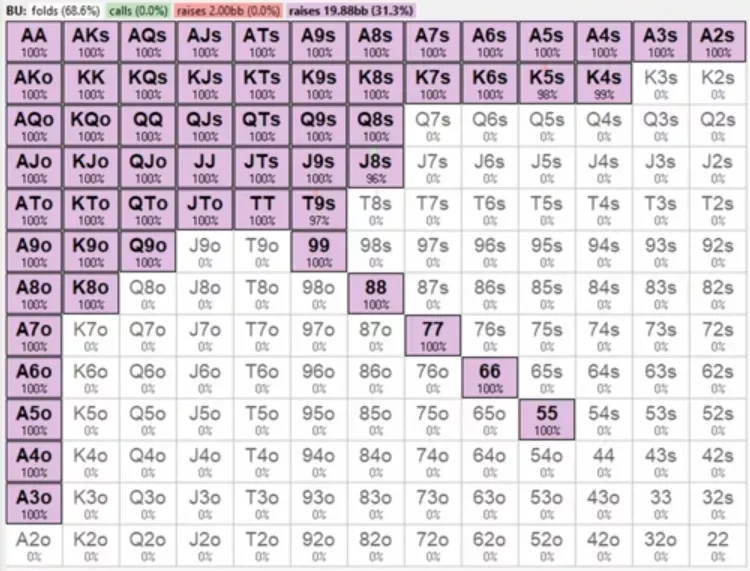So you clicked on this video because you're wondering why Mystery Bounties are so broken. Well, let me show you. Over here, you can see one player, two players raise, call; so one all-in, two all-in, three all-in, five all-in.

Call on the cutoff:

Button reaction:

Small blind reaction:

You see it's broken, but for you to understand why it's broken, let's start from the beginning.
First, let's take a look at the bounty structure. For these equity models, we have used the SCOOP After Party Mystery Bounty. It will play very similarly or the same as long as the Mystery Bounties are very similar in general with payout structure.
If we go ahead and take a look, $9,000 for first place, 223 players get in the money, and the minimum cash is $131. If you take a look at the Mystery Bounties, there is one at $6,500, three at $3,000 each, and the minimum is $52.

So the way it's going to work is whenever you get in the money, you are being introduced to Mystery Bounties. To get in the money means about 85% of the field is gone, meaning they did not get anything. But Mystery Bounties now are getting their own prize pool, and on average, as we can see over here, there is $300 to win if you bust somebody out. That is just average; maybe you get the minimum, maybe you get the highest one, but that's how the model works.

This is why it creates such a broken model.
If you look at the bubble factors, so risk premium means if it's negative, that means you need less equity – 32% less equity, and if it's positive in a typical tournament where there are no bounties, that's where you see it being risk premium. If it's negative, we say negative risk premium or equity drop.
If you are being you have them big blinds against the big blind, let's say you go all-in, minus 32% means let's say somebody jams a million big blinds and you have a million big blinds to call. What now happens is you need 50% odds to make a profitable call or a break-even call. Minus 32 means you need minus 32 of that 50, meaning you only need 18% odds.
So if we take a look at a range, let's say somebody is super tight, they only go all-in with Jacks plus and Ace King. Well, we can do 18% over here; it's any two cards. You can go any two cards. This is why the model is creating very broken results.
So this is a Hold'em resource calculator we can use to put in the equity model. Mystery Bounties, or in this case, Mystery Bounty is really like an average KO you can get, and we can see what the GTO play is. If you are the shorter stack, you need to be kind of tight-ish.
It's not that 35% five-handed tight, right? But if you raise and there is a cutoff player with 25 big blinds, this player needs to call pretty much 100% of the hands because they want to knock you out and have a chance on the Mystery Bounty. Later on, we will also talk about what happens if we take the top bounties out.
So this is you got in the money, there are 223 players remaining. So that's how I basically run to see how the game should be played whenever Mystery Bounties come in. On PokerStars, it comes in when you reach the money. Live, I think, plays pretty much the same.
So if this guy plays call, we can't even go and look at any other node because it's basically 100% playing. There should not be any other node, right? So if this guy goes ahead and clicks a call, you can see button strategy is to go all-in 73% of the hands, right? Because button only covers the first player, doesn't even cover the cutoff.
So if button wants to go all-in 73% of the time and you have 50 big blinds, well, you now want to go all-in with any two cards. And because you're going all-in with any two cards and button went all-in with 73% of the range, you're getting the right price as a hijack to go all-in as well. Because you're cutoff and, well, you called basically 100%, you're also good to go because everybody needs to go all-in with anything they have. This is why this is so broken. This model is so broken.



Okay, let's move on. Let's say this player does find the fold. Let's go to the cutoff. So cutoff covers the button but does not cover either of the blinds, so cutoff wants to also try to get money in against button. So whenever you cover somebody, you're either limping or you raise. All you want to do is figure out how to put all the money in the middle because you want to basically gamble to see if you can win the Mystery Bounty, right? Like that's pretty much how the whole game needs to work with this equity model, and this is GTO.
There we go, so cutoff limps. Now if you're on the button, you're not being... you are being covered from every player. You have no incentive to go ahead and like go all-in with your range, right? There is not much incentive because you're going to get called by 100% every time. There is nothing else that's going to happen. You don't have a calling range, you don't have anything, you just go all-in.
So once you go all-in and small blind again has 50 big blinds, you're all-in as well. All-in because what else can you do? You just want the bounties, you just want to hunt, right? So if small blind goes all-in, suddenly big blind covers cutoff and button, and small blind is all-in with any two cards. Well, big blind wants to go all-in with any two cards basically as well. And if big blind goes all-in with any two cards, cutoff wants to go all-in with any two cards.
I got... this is just ridiculous.

The player on the button has no chance of getting a bounty and therefore will not push all-in with his entire range. Since he has no fold equity, his all-in will be tighter – about 22% of hands:

The button has no other active actions – no calls, no small raises. Only all-in or fold.
Button went all-in. Small blind: Yo, I'm all-in too, I don't have to look at the cards! Let's go! Well, what can he do? If he loves money, he should go hunting for bounty.
Two players are all-in. The big blind covers one of them, and also gets a chance to knock out the limper if he calls. In our model, the BB still has to look at the cards – if there are 82o, 72o or 32o, he will sigh and fold. With all other hands, he will rush into battle.
The cutoff gets the word back and he calls with all the hands he limped with – against three people with random hands he's doing pretty well without the bounty. Hahaha! That's just ridiculous.
Okay, let's continue the analysis, next branch is on the agenda. Cutoff – limp, button – fold. The small blind has the floor. It makes no sense for him to go all-in, but he raises to 4bb with all hands.
The big blind sees the cutoff limp wide, and the small blind isolates him with a 100% range. The optimal response to this action is a clever mix of calls and all-ins:

18% all-ins – finally we see at least some normal value!
On his all-in, the cutoff appears to fold, but the calling range is still wide:

Going triple all-in with 98s – why not? We seem to be standing pretty well.
What the small blind does, I think you already understand – all-in with all hands.
Now let's look at the line where both the hijack and the cutoff fold. The button, when he has the first action, does not cover any of the opponents and should open in a normal, adequate-looking style – all-in with 31% of hands:

The small blind strategy in response to an all-in is to re-push 100%. When you have the biggest stack, there are simply no other options. Remember how little equity you need to play in the black.
The big blind, seeing two all-ins and having a chance for a bounty from one of the opponents, dives third on a very wide, although not 100% range:

This is it, GTO for Mystery Bounty!
How to play when the biggest bounties have already been played out
In the following example, after the bubble passed, four players were eliminated, and each of them received the maximum bounty. Neither $6.5k nor $3.3k can be received anymore, and the maximum bounty of the remaining ones is $1.6k. However, the average bounty is still quite large – $228, more than two buy-ins, and the dynamics with huge negative risk premiums remain.

As you can see, the equity required to get in hasn't changed much. So even when expensive bounties go out of play early, you should still gamble, especially when you have a big stack. You have to load a big stack into the middle of the table without looking at the cards. Maybe you'll have to fold the bottom 5-10% once in a while, but that's it.
Let's look at the positions. In the first example, the hijack opened with a min-raise, but now he strictly limps:

His limp leaves the cutoff with no choice: fold 72o and overlimp with all other hands.
Button pushes 62%:

Small blind? All-in 100% of the time.
It's funny that my calculator doesn't have the ability to see the big blind strategy – the interface doesn't provide for a five-handed all-in, it's too abnormal a situation! But it's clear that he goes all-in, because both the hijack and the cutoff won't fold anything.
What a crazy game.
If the button finds one of the few folds after two limps, the small blind goes all-in for 53%, the BB calls with 87%, the hijack calls with everything, and only the cutoff, since he only covers one opponent, has any sporadic folds. Look at him, what a jerk!
New stack configuration
Finally, let's look at an example in which the hijack has the biggest stack.

The chip leader's game plan doesn't change: he wants to play as many hands as possible because he's on the hunt:

The cutoff with 25bb doesn't cover anyone and therefore calls tightly:

The button will shove about 51% of hands against the cutoff's all-in (remember, he has 80bb). After that, the small blind, covering only one opponent, will call with 35% of hands... If both blinds fold, then the hijack will fold some hands to two all-ins, but very, very few:

But if at least one of the blinds comes in, the hijack is powerless to do anything and must pay all-in on his entire range. In general, the only strategy is to spin the wheel of fortune and try to catch the bounty.
And that, in a nutshell, is the whole strategy of secret bounty tournaments. Now you know everything about them, and good luck with that roulette – I hope you can win big!









